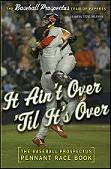As a followup to my latest article on bunting on THT and as a preview of the next article here's a few numbers on sacrifices that were attempted and successful over the past three seasons (2003-2005). You'll have to read the article to ascertain how sacrifice attempts are counting and the success criteria.
Att Succ Pct
7252 5550 0.765306
And by position...a subject I discuss more in the next article...
Position Att Succ Pct
7 356 304 0.854
9 267 223 0.835
4 861 719 0.835
3 137 114 0.832
6 1006 836 0.831
8 693 571 0.824
2 549 451 0.821
10 84 69 0.821
5 378 292 0.772
11 217 161 0.742
1 2704 1810 0.669
And by inning...
Inning Att Succ Pct
1 512 448 0.875
2 783 562 0.718
3 998 714 0.715
4 704 527 0.749
5 961 705 0.734
6 683 551 0.807
7 822 647 0.787
8 819 638 0.779
9 588 450 0.765
10 159 138 0.868
11 105 73 0.695
12 57 46 0.807
13 25 21 0.840
14 15 13 0.867
15 15 12 0.800
16 3 2 0.667
17 2 2 1.000
19 1 1 1.000
I also took a look at those who had 20 or more sacrifice attempts in the period. Here they are ranked by percentage...
>=20 Attempts
Att Succ Pct
Luis Castillo 47 47 1.000
Timo Perez 22 22 1.000
Jerry Hairston 24 23 0.958
Julio Lugo 22 21 0.955
Nook Logan 21 20 0.952
Derek Jeter 41 39 0.951
Deivi Cruz 20 19 0.950
Ryan Freel 19 18 0.947
Alex Cora 30 28 0.933
Miguel Cairo 30 28 0.933
Paul Lo Duca 27 25 0.926
Juan Uribe 34 31 0.912
Omar Vizquel 55 50 0.909
Edgar Renteria 22 20 0.909
Matt Morris 32 29 0.906
Brandon Inge 21 19 0.905
Javier Vazquez 21 19 0.905
Kenny Lofton 21 19 0.905
David Eckstein 40 36 0.900
Luis Gonzalez 20 18 0.900
Michael Tucker 20 18 0.900
Endy Chavez 38 34 0.895
Adam Everett 51 45 0.882
Livan Hernandez 41 36 0.878
Coco Crisp 41 36 0.878
Juan Pierre 57 50 0.877
Tony Womack 32 28 0.875
Jack Wilson 39 34 0.872
Randy Winn 31 27 0.871
Craig Biggio 23 20 0.870
Luis Matos 23 20 0.870
Ramon Santiago 30 26 0.867
Aaron Miles 22 19 0.864
Chone Figgins 35 30 0.857
Russ Ortiz 28 24 0.857
Henry Blanco 21 18 0.857
Andy Pettitte 21 18 0.857
Ramon Martinez 20 17 0.850
Melvin Mora 33 28 0.848
Royce Clayton 50 42 0.840
Angel Berroa 37 31 0.838
Omar Infante 24 20 0.833
Joe McEwing 24 20 0.833
Scott Podsednik 35 29 0.829
Neifi Perez 40 33 0.825
Dave Roberts 28 23 0.821
Tom Glavine 28 23 0.821
Kris Benson 33 27 0.818
Nick Green 22 18 0.818
Claudio Vargas 22 18 0.818
Brian Roberts 32 26 0.813
Marcus Giles 25 20 0.800
Kirk Rueter 20 16 0.800
Roy Oswalt 34 27 0.794
Jason Schmidt 43 34 0.791
Alex Sanchez 52 41 0.788
Brad Ausmus 23 18 0.783
Placido Polanco 23 18 0.783
Ronnie Belliard 23 18 0.783
Brett Tomko 45 35 0.778
Alex Cintron 27 21 0.778
Jeff Suppan 31 24 0.774
Willie Harris 22 17 0.773
Steve Trachsel 30 23 0.767
Woody Williams 30 23 0.767
Jamey Carroll 32 24 0.750
Mike Hampton 24 18 0.750
Jerome Williams 24 18 0.750
Jose Valentin 24 18 0.750
Corey Patterson 24 18 0.750
Kerry Wood 20 15 0.750
Miguel Olivo 20 15 0.750
Jeff Weaver 20 15 0.750
Brad Penny 20 15 0.750
Aaron Cook 20 15 0.750
Randy Wolf 20 15 0.750
Juan Castro 26 19 0.731
Josh Fogg 33 24 0.727
Carlos Zambrano 22 16 0.727
Cristian Guzman 53 38 0.717
Quinton McCracken 21 15 0.714
Cory Lidle 24 17 0.708
Brett Myers 34 24 0.706
Odalis Perez 34 24 0.706
John Thomson 27 19 0.704
Mark Prior 27 19 0.704
Greg Maddux 36 25 0.694
Rafael Furcal 26 18 0.692
Aaron Rowand 26 18 0.692
Oliver Perez 29 20 0.690
Shawn Estes 28 19 0.679
Cesar Izturis 39 26 0.667
Brandon Webb 36 24 0.667
Adam Eaton 24 16 0.667
Kazuhisa Ishii 29 19 0.655
Jake Peavy 29 19 0.655
Ben Sheets 33 21 0.636
John Patterson 22 14 0.636
AJ Burnett 27 17 0.630
Matt Clement 21 13 0.619
Josh Beckett 31 19 0.613
Brian Lawrence 31 19 0.613
Carl Pavano 23 14 0.609
Dontrelle Willis 22 13 0.591
Jason Jennings 26 15 0.577
Chris Carpenter 27 15 0.556
Vicente Padilla 20 11 0.550
Paul Wilson 26 13 0.500
Al Leiter 22 11 0.500
Kevin Millwood 23 11 0.478
Horacio Ramirez 21 10 0.476
Kip Wells 24 11 0.458
Eric Milton 22 10 0.455
Aaron Harang 20 8 0.400
Ramon Ortiz 19 7 0.368
Mark Redman 23 8 0.348
Doug Davis 29 9 0.310
Note that Matt Morris tops the list of pitchers. Interesting that Luis Castillo has been perfect. Stay tuned.



125x125_10off+copy.jpg)


